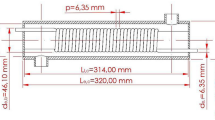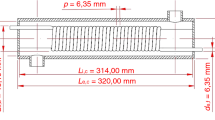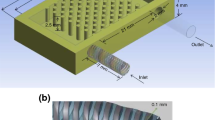Abstract
This study evaluates the performance of silver nanofluid as a coolant in a helical shell and tube heat exchanger using water as the hot fluid. The investigation characterizes silver nanoparticles and finds they are predominantly spherical and negatively charged, resulting in stable nanofluid. The study conducts multilevel factorial analysis using different volumetric fractions of nanoparticles. It identifies fluid flow rate as having the most significant influence on effectiveness, followed by the inlet temperature of the hot fluid and the volumetric fraction of nanoparticles. The study derives a linear regression equation from calculating the effectiveness of the heat exchanger. The smallest error between calculated and experimental effectiveness was 3.8%, observed at a volumetric flow of 40 L h−1, with an average Reynolds number of 4018, and a hot fluid inlet temperature of 60 °C. Although the cost of producing and characterizing silver nanoparticles was not justified, the study expands knowledge about using a scarcely explored nanofluid as a coolant in heat exchangers. The analysis shows that although the silver nanofluid used in the present study showed an increase in effectiveness compared to its base fluid (water), the cost of production and characterization of the silver nanoparticles were not justified.






























Similar content being viewed by others
Abbreviations
- AgNF:
-
Silver nanofluid
- 3D:
-
Three-dimensional
- PVP:
-
Polivinilpirrolidona
- 2D:
-
Two-dimensional
- RPSL:
-
Localized surface plasmon resonance
- UV:
-
Ultraviolet
- CPU:
-
Central processing unit
- Ag - 1.5%:
-
Nanofluid with the volumetric concentration of 1.5%
- Ag - 2.5%:
-
Nanofluid with the volumetric concentration of 2.5%
- MTH:
-
Microtube helicoidal
- EES:
-
Engineering equation solver
- pH:
-
Hydrogenionic potential
- TCCTH:
-
Hull heat exchanger and helical tube
References
Abdollahi A, Botlani Esfahani MB, Sajadi SM, et al. Experimental study of pool boiling heat transfer coefficient for DI-water-based nanofluids containing nickel oxide in a constant magnetic field. Int J Thermophys. 2023;44:1–21. https://doi.org/10.1007/S10765-023-03173-7/METRICS.
Starinskaya EM, Miskiv NB, Nazarov AD, et al. (2023) Evaporation of suspended nanofluid (SiO2 /water) droplets: experimental results and modelling. Int J Thermophys. 2023;44(5):1–20. https://doi.org/10.1007/S10765-023-03164-8.
Mansouri M, Zamzamian SAH. Experimental studies on the heat transfer characteristics of alumina/water nanofluid inside a helical coil tube. Heat Mass Transf/Waerme- und Stoffuebertragung. 2021;57:551–64. https://doi.org/10.1007/S00231-020-02976-W/METRICS.
Hamid M, Seyed Mostafa TG, Alimorad R, Masoumeh M. A Novel approach for energy and water conservation by using silver-carbon quantum dots hybrid nanofluids in wet cooling towers systems. J Therm Sci. 2021;30:1827–41. https://doi.org/10.1007/S11630-021-1502-8/METRICS.
Zadeh AD, Toghraie D. Experimental investigation for developing a new model for the dynamic viscosity of silver/ethylene glycol nanofluid at different temperatures and solid volume fractions. J Therm Anal Calorim. 2018;131:1449–61. https://doi.org/10.1007/S10973-017-6696-3/METRICS.
Hedeshi M, Jalali A, Arabkoohsar A, Amiri Delouei A. Nanofluid as the working fluid of an ultrasonic-assisted double-pipe counterflow heat exchanger. J Therm Anal Calorim. 2023;2023:1–13. https://doi.org/10.1007/S10973-023-12102-7.
Iyahraja S, Selwin Rajadurai J, Siva Subramanian B, et al. Investigation on convective heat transfer and friction factor of silver–water nanofluid under laminar flow – an experimental study. Heat Mass Transf/Waerme- und Stoffuebertragung. 2019;55:3029–39. https://doi.org/10.1007/S00231-019-02640-Y/METRICS.
Jamiatia M. Numerical investigation in comparing the influence of water-silver-magnesium oxide hybrid nanofluid and water-silver normal nanofluid on fluid flow, heat transfer and entropy generation in an enclosure with rotating heat sources. Eur Phys J Plus. 2019;134(8):1–15. https://doi.org/10.1140/EPJP/I2019-12750-7.
Shafiey Dehaj M, Hajabdollahi H. Numerical study on performance enhancement of the fin and tube heat exchanger using different nanoparticle shapes. Int J Environ Sci Technol. 2022;19:1407–22. https://doi.org/10.1007/S13762-021-03199-0/METRICS.
Dalkılıç AS, Mercan H, Özçelik G, Wongwises S. Optimization of the finned double-pipe heat exchanger using nanofluids as working fluids. J Therm Anal Calorim. 2021;143:859–78. https://doi.org/10.1007/S10973-020-09290-X/METRICS.
Khodabandeh E, Boushehri R, Akbari OA, et al. Numerical investigation of heat and mass transfer of water—silver nanofluid in a spiral heat exchanger using a two-phase mixture method. J Therm Anal Calorim. 2021;144:1003–12. https://doi.org/10.1007/S10973-020-09533-X/METRICS.
Xian HW, Sidik NAC, Saidur R. Impact of different surfactants and ultrasonication time on the stability and thermophysical properties of hybrid nanofluids. Int Commun Heat Mass Transfer. 2020;110:104389. https://doi.org/10.1016/J.ICHEATMASSTRANSFER.2019.104389.
Samal SK, Moharana MK. Thermo-hydraulic and entropy generation analysis of recharging microchannel using water-based graphene–silver hybrid nanofluid. J Therm Anal Calorim. 2021;143:4131–48. https://doi.org/10.1007/S10973-020-09382-8/METRICS.
Ranjbarzadeh R, Akhgar A, Taherialekouhi R, et al. Improve the heat exchanger efficiency via examine the graphene oxide nanoparticles: a comprehensive study of the preparation and stability, predict the thermal conductivity and rheological properties, convection heat transfer and pressure drop. J Therm Anal Calorim. 2022;147:7509–21. https://doi.org/10.1007/S10973-021-11002-Y/METRICS.
Bhattad A, Sarkar J, Ghosh P. Heat transfer characteristics of plate heat exchanger using hybrid nanofluids: effect of nanoparticle mixture ratio. Heat Mass Transf/Waerme- und Stoffuebertragung. 2020;56:2457–72. https://doi.org/10.1007/S00231-020-02877-Y/METRICS.
Selvam C, Mohan Lal D, Harish S. Convective heat transfer behaviour of water-ethylene glycol-mixture with silver nanoparticles under laminar flow conditions. J Mech Sci Technol. 2018;32:2191–9. https://doi.org/10.1007/S12206-018-0429-9/METRICS.
Cao Y, Taghvaie Nakhjiri A, Sarkar SM, Ghadiri M. Integration of ANN and NSGA-II for optimization of Nusselt number and pressure drop in a coiled heat exchanger via water-based nanofluid containing alumina and Ag nanoparticles. Arab J Sci Eng. 2022. https://doi.org/10.1007/S13369-022-07480-3/METRICS.
Shah SNA, Shahabuddin S, Sabri MFM, et al. Experimental investigation on stability, thermal conductivity and rheological properties of rGO/ethylene glycol based nanofluids. Int J Heat Mass Transf. 2020;150:118981. https://doi.org/10.1016/J.IJHEATMASSTRANSFER.2019.118981.
Samruaisin P, Wongcharee K, Chuwattanakul V, Eiamsa-ard S. Silver–water nanofluid flow and convective heat transfer in a microfin tube equipped with loose-fit twisted tapes. J Therm Anal Calorim. 2020;140:2541–54. https://doi.org/10.1007/S10973-019-08984-1/FIGURES/11.
Kamenik B, Elcioglu EB, Turgut A, et al. Numerical analysis of performance uncertainty of heat exchangers operated with nanofluids. Int J Thermofluids. 2022;14:100144. https://doi.org/10.1016/J.IJFT.2022.100144.
Afshari F, Sözen A, Khanlari A, Tuncer AD. Heat transfer enhancement of finned shell and tube heat exchanger using Fe2O3/water nanofluid. J Cent South Univ. 2021;28:3297–309. https://doi.org/10.1007/S11771-021-4856-X/METRICS.
Yan SR, Moria H, Pourhedayat S, et al. A critique of effectiveness concept for heat exchangers; theoretical-experimental study. Int J Heat Mass Transf. 2020;159:120160. https://doi.org/10.1016/J.IJHEATMASSTRANSFER.2020.120160.
Rao JBB, Raju VR. Numerical and heat transfer analysis of shell and tube heat exchanger with circular and elliptical tubes. Int J Mech Mater Eng. 2016;11:1–18. https://doi.org/10.1186/S40712-016-0059-X/FIGURES/36.
Saffarian MR, Fazelpour F, Sham M. Numerical study of shell and tube heat exchanger with different cross-section tubes and combined tubes. Int J Energy Environ Eng. 2019;10:33–46. https://doi.org/10.1007/S40095-019-0297-9/FIGURES/14.
Attalla M, Maghrabie HM (2019) An experimental study on heat transfer and fluid flow of rough plate heat exchanger using Al2O3/water nanofluid. 101080/0891615220191625469 33:261–281.
Kumar S, Singh SK, Sharma D (2022) Heat transfer characteristics of plate heat exchanger with bubble fin using Al2O3/water nanofluid: numerical investigation. 101080/0145763220222148342.
Du T, Du W. Characteristics of flow and heat transfer of shell-and-tube heat exchangers with overlapped helical baffles. Front Eng Manage. 2019;6:70–7. https://doi.org/10.1007/S42524-019-0005-8.
Ahmadi MR, Toghraie D. Numerical analysis of flow and heat transfer in a shell and tube heat exchanger in the gas recirculation cooling system of a diesel engine and the effect of nanofluid on its performance. J Therm Anal Calorim. 2022;147:4853–71. https://doi.org/10.1007/S10973-021-10831-1/METRICS.
Basit Shafiq M, Allauddin U, Qaisrani MA, et al. Thermal performance enhancement of shell and helical coil heat exchanger using MWCNTs/water nanofluid. J Therm Anal Calorim. 2022;147:12111–26. https://doi.org/10.1007/S10973-022-11405-5/METRICS.
Shahsavar A, Bakhshizadeh MA, Arici M, et al. Numerical study of the possibility of improving the hydrothermal performance of an elliptical double-pipe heat exchanger through the simultaneous use of twisted tubes and non-Newtonian nanofluid. J Therm Anal Calorim. 2021;143:2825–40. https://doi.org/10.1007/S10973-020-10201-3/METRICS.
Maddah H, Ghasemi N, Keyvani B, Cheraghali R. Experimental and numerical study of nanofluid in heat exchanger fitted by modified twisted tape: exergy analysis and ANN prediction model. Heat Mass Transfer/Waerme- und Stoffuebertragung. 2017;53:1413–23. https://doi.org/10.1007/S00231-016-1906-2/METRICS.
Shahsavar A, Moradi M, Bahiraei M. Heat transfer and entropy generation optimization for flow of a non-Newtonian hybrid nanofluid containing coated CNT/Fe3O4 nanoparticles in a concentric annulus. J Taiwan Inst Chem Eng. 2018;84:28–40. https://doi.org/10.1016/J.JTICE.2017.12.029.
Graves JE, Latvytė E, Greenwood A, Emekwuru NG. Ultrasonic preparation, stability and thermal conductivity of a capped copper-methanol nanofluid. Ultrason Sonochem. 2019;55:25–31. https://doi.org/10.1016/J.ULTSONCH.2019.02.028.
Mahbubul IM, Elcioglu EB, Amalina MA, Saidur R. Stability, thermophysical properties and performance assessment of alumina–water nanofluid with emphasis on ultrasonication and storage period. Powder Technol. 2019;345:668–75. https://doi.org/10.1016/J.POWTEC.2019.01.041.
Asadi A, Alarifi IM, Ali V, Nguyen HM. An experimental investigation on the effects of ultrasonication time on stability and thermal conductivity of MWCNT-water nanofluid: finding the optimum ultrasonication time. Ultrason Sonochem. 2019;58:104639. https://doi.org/10.1016/J.ULTSONCH.2019.104639.
Cacua K, Ordoñez F, Zapata C, et al. Surfactant concentration and pH effects on the zeta potential values of alumina nanofluids to inspect stability. Colloids Surf A Physicochem Eng Asp. 2019;583:123960. https://doi.org/10.1016/J.COLSURFA.2019.123960.
Ambreen T, Kim MH. Effects of variable particle sizes on hydrothermal characteristics of nanofluids in a microchannel. Int J Heat Mass Transf. 2018;120:490–8. https://doi.org/10.1016/J.IJHEATMASSTRANSFER.2017.12.067.
Subramanian R, Senthil Kumar A, Vinayagar K, Muthusamy C. Experimental analyses on heat transfer performance of TiO2–water nanofluid in double-pipe counterflow heat exchanger for various flow regimes. J Therm Anal Calorim. 2020;140:603–12. https://doi.org/10.1007/S10973-019-08887-1/METRICS.
Author information
Authors and Affiliations
Corresponding author
Additional information
Publisher's Note
Springer Nature remains neutral with regard to jurisdictional claims in published maps and institutional affiliations.
Rights and permissions
Springer Nature or its licensor (e.g. a society or other partner) holds exclusive rights to this article under a publishing agreement with the author(s) or other rightsholder(s); author self-archiving of the accepted manuscript version of this article is solely governed by the terms of such publishing agreement and applicable law.
About this article
Cite this article
Alphonse, P., Muthukumarasamy, K. & Dhairiyasamy, R. Exploring the effects of nanofluids on nucleate boiling: a theoretical and experimental investigation. J Therm Anal Calorim 148, 7881–7898 (2023). https://doi.org/10.1007/s10973-023-12278-y
Received:
Accepted:
Published:
Issue Date:
DOI: https://doi.org/10.1007/s10973-023-12278-y




